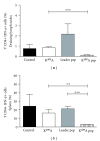The Role of M. leprae Hsp65 Protein and Peptides in the Pathogenesis of Uveitis
- PMID: 22966424
- PMCID: PMC3433114
- DOI: 10.1155/2012/197648
The Role of M. leprae Hsp65 Protein and Peptides in the Pathogenesis of Uveitis
Abstract
Experimental autoimmune uveitis (EAU) is a well established model for immune-mediated organ-specific disease. Our group has recently shown that the M. leprae Hsp65 aggravated the uveitis in mice; in the present study, we evaluated the action of M. leprae K(409)A mutant protein and the synthetic peptides Leader pep and K(409)A pep (covering amino acids residues 352-371 of WT and K(409)A proteins of M. leprae Hsp65, resp.) on the pathogenesis of EAU. Mice received the 161-180 IRBP peptide and B. pertussis toxin followed by the intraperitoneal inoculation of K(409)A protein or the Leader pep or K(409)A pep. The Leader pep aggravated the disease, but mice receiving the K(409)A pep did not develop the disease and presented an increase in IL-10 levels by spleen cells and a decrease in the percentage of CD4+ IFN-γ+ T cells. Moreover, animals receiving the Leader pep presented the highest scores of the disease associated with increase percentage of CD4+ IFN-γ+ T cells. These results would contribute to understanding of the pathogenesis of EAU and support the concept that immune responses to Hsp are of potential importance in exacerbating, perpetuating, or even controlling organ-restricted autoimmune diseases, and it is discussed the irreversibility of autoimmune syndromes.
Figures





Similar articles
-
Administration of Mycobacterium leprae rHsp65 aggravates experimental autoimmune uveitis in mice.PLoS One. 2009 Nov 19;4(11):e7912. doi: 10.1371/journal.pone.0007912. PLoS One. 2009. PMID: 19936251 Free PMC article.
-
A Mycobacterium leprae Hsp65 mutant as a candidate for mitigating lupus aggravation in mice.PLoS One. 2011;6(9):e24093. doi: 10.1371/journal.pone.0024093. Epub 2011 Sep 22. PLoS One. 2011. PMID: 21961033 Free PMC article.
-
[Effects of leflunomide on experimental autoimmune uveitis in Lewis rats].Zhonghua Yan Ke Za Zhi. 2015 Oct;51(10):754-61. Zhonghua Yan Ke Za Zhi. 2015. PMID: 26693771 Chinese.
-
The immunopathogenesis of chronic and relapsing autoimmune uveitis - Lessons from experimental rat models.Prog Retin Eye Res. 2018 Jul;65:107-126. doi: 10.1016/j.preteyeres.2018.02.003. Epub 2018 Feb 27. Prog Retin Eye Res. 2018. PMID: 29496590 Review.
-
[Intraocular inflammation and homeostasis of the eye].Nippon Ganka Gakkai Zasshi. 2009 Mar;113(3):344-77; discussion 378. Nippon Ganka Gakkai Zasshi. 2009. PMID: 19348183 Review. Japanese.
Cited by
-
Immunotherapy of tuberculosis with Mycobacterium leprae Hsp65 as a DNA vaccine triggers cross-reactive antibodies against mammalian Hsp60 but not pathological autoimmunity.Hum Vaccin Immunother. 2014;10(5):1238-43. doi: 10.4161/hv.28249. Epub 2014 Mar 7. Hum Vaccin Immunother. 2014. PMID: 24607935 Free PMC article.
References
-
- Caspi RR, Roberge FG, Chan CC, et al. A new model of autoimmune disease. Experimental autoimmune uveoretinitis induced in mice with two different retinal antigens. Journal of Immunology. 1988;140(5):1490–1495. - PubMed
-
- Rizzo LV, Silver P, Wiggert B, et al. Establishment and characterization of a murine CD4+ T cell line and clone that induce experimental autoimmune uveoretinitis in B10.A mice. Journal of Immunology. 1996;156(4):1654–1660. - PubMed
-
- Thole JER, Hindersson P, De Bruyn J, et al. Antigenic relatedness of a strongly immunogenic 65 kDa mycobacterial protein antigen with a similarly sized ubiquitous bacterial common antigen. Microbial Pathogenesis. 1988;4(1):71–83. - PubMed
-
- Xiao Q, Mandal K, Schett G, et al. Association of serum-soluble heat shock protein 60 with carotid atherosclerosis: clinical significance determined in a follow-up study. Stroke. 2005;36(12):2571–2576. - PubMed
LinkOut - more resources
Full Text Sources
Research Materials
Miscellaneous

